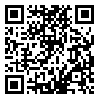Volume 10, Issue 3 (May & Jun 2020)
J Research Health 2020, 10(3): 151-158 |
Back to browse issues page
Download citation:
BibTeX | RIS | EndNote | Medlars | ProCite | Reference Manager | RefWorks
Send citation to:



BibTeX | RIS | EndNote | Medlars | ProCite | Reference Manager | RefWorks
Send citation to:
Heydari S, Fattahi Ardakani M, Jamei E, Salahshur S. Determinants of Completing the Medication Reconciliation Form Among Nurses Based on Diffusion of Innovation Theory. J Research Health 2020; 10 (3) :151-158
URL: http://jrh.gmu.ac.ir/article-1-1516-en.html
URL: http://jrh.gmu.ac.ir/article-1-1516-en.html
1- Department of Medical Education, Medical Education Research Center, Isfahan University of Medical Sciences, Iran.
2- Department of Health Education, School of Public Health, Shahid Sadoughi University of Medical Sciences, Yazd, Iran. ,mjfattahi57@gmail.com
3- Department of Health Education, School of Public Health, Shahid Sadoughi University of Medical Sciences, Yazd, Iran.
2- Department of Health Education, School of Public Health, Shahid Sadoughi University of Medical Sciences, Yazd, Iran. ,
3- Department of Health Education, School of Public Health, Shahid Sadoughi University of Medical Sciences, Yazd, Iran.
Abstract: (3851 Views)
Background: Patients afety is a global medical concern with remarkable influence on the health of patients. Studies have suggested that treatment-related damages occur in approximately 10% of patients at variable degrees, and more than a quarter of these damages are associated with medication errors. Medication errors could be diminished during patient hospitalization and transferusing integrated medication reconciliation. This study aimed to evaluate the determinants of completing integrated medication reconciliation forms based on the theory of diffusion of innovations among the nurses of Ziaei Hospital of Ardakan City and Imam Jafar Sadegh Hospital of Meybod City, Yazd.
Materials and Methods: In this study, required data were collected from the nurses engaged in the admission centers of the selected hospitals using researcher-made questionnaires. Data analysis was performed in SPSS v. 19 using Spearman’s correlation-coefficient and Mann-Whitney U test.
Results: Findings of this study regarding different structures of integrated medication reconciliation forms were as follows: relative advantage (86.5 of the maximum score), perceived compatibility (40.75), perceived complexity (44.3), visibility (83.6), and testability (79.8). Moreover, significant correlations were observed between the structures of comparative advantage, perceived compatibility, testability, and visibility.
Conclusion: According to the results of this study, promoting the knowledge and professional attitude of nurses could increase their compatibility regarding the implementation of integrated medication reconciliation. In addition, elaboration on the proper principles of the completion of this form could reduce the mean score of the perceived complexity structure.
Materials and Methods: In this study, required data were collected from the nurses engaged in the admission centers of the selected hospitals using researcher-made questionnaires. Data analysis was performed in SPSS v. 19 using Spearman’s correlation-coefficient and Mann-Whitney U test.
Results: Findings of this study regarding different structures of integrated medication reconciliation forms were as follows: relative advantage (86.5 of the maximum score), perceived compatibility (40.75), perceived complexity (44.3), visibility (83.6), and testability (79.8). Moreover, significant correlations were observed between the structures of comparative advantage, perceived compatibility, testability, and visibility.
Conclusion: According to the results of this study, promoting the knowledge and professional attitude of nurses could increase their compatibility regarding the implementation of integrated medication reconciliation. In addition, elaboration on the proper principles of the completion of this form could reduce the mean score of the perceived complexity structure.
Type of Study: Orginal Article |
Subject:
● Psychosocial Health
Received: 2018/01/12 | Accepted: 2018/05/23 | Published: 2020/06/14
Received: 2018/01/12 | Accepted: 2018/05/23 | Published: 2020/06/14
| Rights and permissions | |
 |
This work is licensed under a Creative Commons Attribution-NonCommercial 4.0 International License. |









